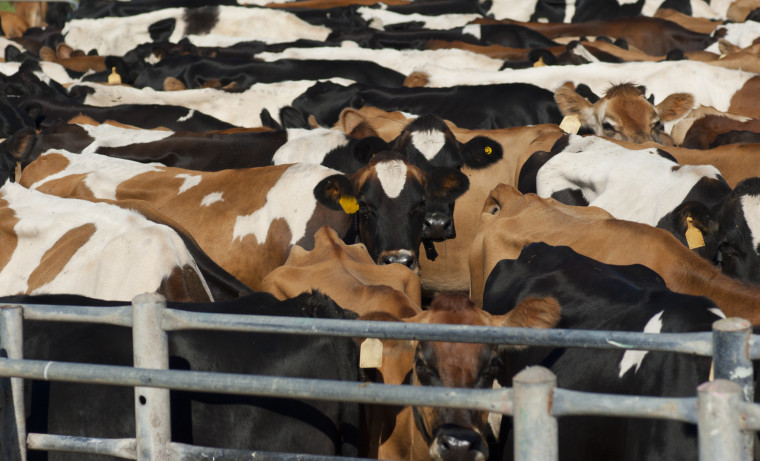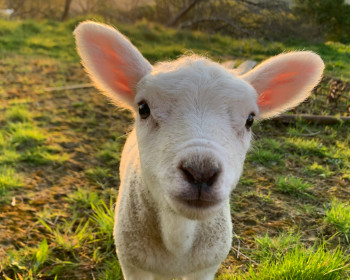The Glaring Absence at COP26: Any Meaningful Focus on Animals
As global leaders meet in Glasgow at COP26, not enough is being done to consider the interests of animals in the conversation.
Open gallery

Climate change is in the news as global leaders meet in Glasgow, Scotland for COP26. How will humanity meet the most important challenge of our time? But, there is a surprising silence on how animals are impacting climate change and how climate change is impacting animals. And, the failure to bring animals into the discussion will have dire consequences, for both animals and humans.
COP26
Under the 1992 United Nations Framework Convention on Climate Change (UNFCCC), every country is treaty-bound to “avoid dangerous climate change” and find ways to reduce global greenhouse gas emissions. COP26, happening from November 1-12, 2021, is where more than 120 heads of state and government and thousands of diplomats are meeting to set new targets for addressing climate change. So far, animals have been left out of these important climate change conversations and that is unlikely to change in the waning hours of COP26. The importance of bringing animals into the climate change discussion is not minor. On a worldwide basis, wildlife will face greater odds against survival, and perhaps even more to the point, the massive worldwide production of meat is one of the primary causes of climate change. The failure of climate negotiators to address the Cow in the Room will be catastrophic.
Climate Change Threats to Wild Animals
Climate change is altering key habitat elements that are essential to wildlife survival. Rising temperatures risk destabilizing the balance between wildlife and their ecosystems. Snowshoe hares, for example, have evolved to turn white in winter to blend in with the snow in order to hide from predators. With the rising temperatures in the snowshoe hares’ habitat, the snow is melting much earlier than the hares are accustomed to, leaving them vulnerable to predators and causing declines in their populations. Rising temperatures and booming parasite populations are expected to cause moose to move further north as warmer winters with less snow are leading to higher numbers of winter ticks—weakening the animal’s immune system and often ending in death.
Polar bears—who have become a symbol of climate change—rely almost exclusively on the sea-ice environment. Their decline in population is attributed to Arctic warming. Polar bears need sea ice to hunt seals and move across the large ranges of foraging habitat. Walruses and other Arctic species are facing similar challenges as ice continues to melt. In the Gulf of Maine, puffins are having difficulty finding their primary food sources of white hake and herring. As the sea warms, the fish are moving into deeper waters, making it harder for puffins to catch a meal and feed their young. Adult puffins have started feeding their young butterfish, but young puffins cannot swallow these large fish, and many are dying of starvation.
Many species take their cues about when to migrate, flower, nest, or mate from seasonal changes in temperature, precipitation, and daylight. Climate change is confusing those signals and forcing wildlife to alter their life cycle and seasonal events. Monarch butterflies, for example, are heavily dependent on environmental cues for reproduction, migration, and hibernation. Climate change has the potential to significantly impact these essential functions. Some animals are laying eggs, migrating, or emerging from hibernation much earlier than they used to, only to find that the plants or the insects they need for food have not yet emerged. Severe droughts are killing the plants that wildlife depend on for food and shelter; for example, fruit that African forest elephants depend upon has declined by more than 80% due to climate change, at the same time as there has been a substantial decline in the elephants’ body condition. A report in Science concluded that these findings “suggest that the capacity of the ecosystem to support the elephant population is decreasing…”
These examples only scratch the surface of how wildlife has been and will continue to be affected by climate change. The negative impacts on wild animals have reached an unprecedented pace and species extinction is accelerating.
Industrial Animal Agriculture’s Impact on Climate Change.
More than 88 billion land animals are raised and slaughtered for food every year. Cattle production alone is responsible for an estimated 12% of human-induced greenhouse gas emissions globally. That is just under the 16.2% estimate of greenhouse gas emissions emitted by cars, trains, ships, and planes. Industrial animal agriculture also contributes to water pollution by releasing large amounts of manure, chemicals, antibiotics, and growth hormones into water sources. It is a significant driver of deforestation, biodiversity loss, species extinction, land degradation, and exhaustion of water resources, just to name a few. Despite industrial animal agriculture being one of the largest contributors to climate change, it has not received nearly the focus it deserves in climate discussions. At COP26, a focus on industrial animal agriculture is absent in all but the most general terms around “sustainable agriculture.” Interviewed by The Guardian, U.S. Secretary of Agriculture, Thomas Vilsack stated, “I do not think we have to reduce the amount of meat or livestock produced in the U.S. And a significant percentage is exported. It’s not a question of eating more or less or producing more or less. The question is making production more sustainable.”
Professor of Practice Joyce Tischler, who teaches our Industrial Animal Agriculture Law course, responded to Vilsack’s comments, saying, “Vilsack, an ardent supporter of the meat industry, is marching out the same, tired old rhetoric: we’ll fix the problem with technology. He’s wrong! The consequences of the massive and growing meat industry on climate and the environment could not be more clear. It is absurd that COP26 is unwilling to even consider the role of industrial animal agriculture in climate negotiations. That’s analogous to a peace conference in which no one mentions nuclear proliferation.” At the Center for Animal Law Studies, we are at the forefront of educating future leaders to address the myriad of issues presented by the massive industrial animal agriculture industry, and students in Professor Tischler’s class address the connections between animal agriculture, climate change, food safety, public health, animal welfare, the environment, and environmental justice issues, such as the impact of animal agriculture on nearby, marginalized communities.
Where Do We Go from Here?
With one million animal and plant species being threatened with extinction—many within decades—the stakes could not be higher. Yet the obvious solutions, like reducing the global consumption of meat and dairy—are being dismissed and downplayed. Meanwhile, global leaders are failing to explore innovative solutions. Industrial animal agriculture is both a cause, and has the potential to be a solution, to the climate crisis.
We offer a few solutions:
- Squarely Address the “Cow in the Room”. The current food production system is obviously not working. The system is dominated by big agriculture (Big Ag) lobbyists and megacorporations profiting from the harm they’re causing to animals, the environment, and people. The true costs of industrial animal agriculture are carefully hidden from the public in favor of selling “cheap meat” to feed a growing population. Of course, the massive and large-scale production of meat, dairy and eggs is anything but cheap: taxpayers pay to clean up the environment and we’re still left with enormous greenhouse gas emissions, deforestation, and food safety issues, such as Salmonella and E. coli. The solution is not a complicated one—reduce or eliminate the consumption of meat, dairy and eggs.
- Facilitate the Development of Sustainable Protein. The future of food production must shift toward alternatives that do not involve raising and slaughtering almost 88 billion animals a year (and growing) across the world. That shift has already begun. Years ago, the sales of plant-based burgers, such as Beyond Beef and the Impossible Burger, began to soar and are now routinely on menus. Substitutes for dairy and eggs are popular now too. Sustainable protein sources are the future of our food industry. A recently released report by researchers at DigitalFoodLab listed sustainable protein as one of the five mega-trends that will shape the future of the food industry. DigitalFoodLab pointed to “billions invested, dozens of new products reaching our supermarket shelves and discussions about almost magical technologies such as cellular agriculture. The goal here is simple: provide the world with multiple new reliable, sustainable and affordable sources of proteins. These won’t replace animal proteins in the short term but they may at least absorb the growing demand for more protein in the next 10 to 15 years.” In February, 2022, CALS will host a Food Law Forum with the Center for Business Law and Innovation, and the focus will be on sustainable protein. Stay tuned for more details.
- Get Political. The interests of animals must become normalized as a regular part of our political discourse. Australia has already moved in that direction. The Animal Justice Party has three elected Members of Parliament and the Party “actively campaigns at a government policy level against animal atrocities relating to wildlife destruction, factory farming, live export, companion and domestic animal abuse, and the use of animals for sport and entertainment.” Our Animal Law LLM Alumni, Tess Vickery, is the Legal and Policy Advisory to one of these Members of Parliament. Canada also recently moved in that direction, with major party candidates first urging their parties to incorporate animal welfare issues into their platforms. And, the change was swift: all of Canada’s major political parties have included some form of animal protection in their campaign platforms. Some of the candidates even participated in the nation’s first-ever animal protection election debate. At a minimum, we should be asking our politicians their stance on animal protection issues and, better yet, giving those politicians who unabashedly care about animal protection our votes.
- Give Animals a Seat at the Table. A recent article from Sentient Media addresses the growing chorus calling for a new international institution that represents the interests of animals, as opposed to the interests of industries that exploit animals, and explains how this might work. It would include a body of scientists, ethicists and other experts representing animals from academia, biology, and other appropriate areas of expertise. This could look like a version of what environmentalists have suggested being created in the Earth system council, but one that fully encompasses animal representation. This type of council would have voting seats with an elected representative that would have the power to make recommendations at conferences like COP26. By having a seat at the table, animal advocates would be able to recommend solutions in favor of the health and very existence of animals. At the bare minimum, we would be actually focusing attention on the needs of animals in important settings like COP26.
Effectively responding to climate change will require a shift toward more effective means of food production. The lives of millions of species have been negatively impacted by climate change and their futures, and ours, are intertwined. We cannot adequately address climate change while ignoring animals. Instead, we must aim to improve the lives of animals, and we will necessarily improve the quality of the environment, the climate, and our own quality of life.

The Center for Animal Law Studies (CALS) was founded in 2008 with a mission to educate the next generation of animal law attorneys and advance animal protection through the law. With vision and bold risk-taking, CALS has since developed into a world-renowned animal law epicenter, with the most comprehensive animal law curriculum offered anywhere. In addition, CALS is the only program that offers an advanced legal degree in animal law, now offered both in-person and online, and three specialty animal law clinics. CALS is a nonprofit organization and is only able to provide these educational opportunities through donations and grants.
More Center for Animal Law Studies Stories
Center for Animal Law Studies is located in Wood Hall on the Law Campus.
MSC: 51
email cals@lclark.edu
voice 503-768-6960
Center for Animal Law Studies
Lewis & Clark Law School
10101 S. Terwilliger Boulevard MSC 51
Portland OR 97219

